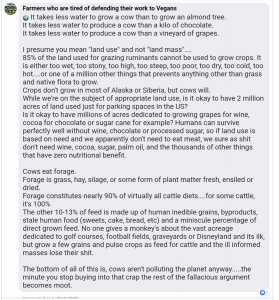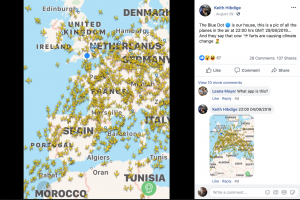It’s an interesting time to be involved with animal agriculture. The negative media, cruel animal-rights activism, and consumer misperceptions alone are disheartening to say the least. Simultaneously there are more opportunities than ever to innovate, expand old markets, reach new customers, and promote products.
All animal industries encourage online and in-person “agvocating” — using both direct and indirect methods. This has been incredibly successful, even birthing some farmer and veterinarian “internet celebrities.” But even in this day and age, we still face many recurring questions, misperceptions, and arguments, especially in terms of hot-button issues such as the environment. In the midst of this, it’s fair to ask: Are we using the best discussion angles and responses to explain our industries?
A post by the increasingly popular Facebook page “Farmers who are tired of defending their work to Vegans” had a particular comment go mini viral on the ag side of the internet. This was in response to a comment about the environmental-ethical issue surrounding beef and dairy production because of “how much water consumption, land mass and food it takes to grow a cow.”

Without dissecting the technicalities of this response, I personally find it very refreshing to see some discussion generated around societal use of precious limited landmass and byproduct recycling.
On urban and suburban excursions it’s a commonality to see remaining fields, fallow or tilled, with brash “FOR SALE: COMMERCIALLY ZONED” signs. Arable fields are regularly paved over in a heartbeat, but once the topsoil is scraped off and the concrete is poured, the land is irreclaimable.
Chances are, you’ve seen the apple demonstration about how only 1/32 of the Earth’s soil is, without limitations, perfectly arable. If not, its more than worth the watch. On average, the estimates are this equates to 3.5 percent of the Earth’s total surface for this purpose. And it seems like there isn’t much thought given to exactly how we divvy that land up and what becomes of farmland once it goes up for sale.
These are the kinds of perspectives and thoughts your everyday American may never consider. There is absolutely something to be said for these regards, but perhaps the more important aspect is how we say them.
There is a danger of this leading us to dance too closely between the edge of reasonable concern and the “whataboutism” logical fallacy. Unrestrained, these kinds of land comparisons can very quickly fall closely toward this edge if used improperly. Likewise, implicating consumerism-driven guilt tends to quickly shut discussions down and stir emotions.
One judicial use of these facts is as an open-ended conversation starters. Opening the floor for commentary sets you up for positivity right away. It’s perfectly fair to question why The Guardian was paid $886,000 to write articles specifically criticizing animal agriculture’s impact, but not for other industries such as transportation, travel, textiles, and power.
Or how would the urban-dweller react to last year’s American Farmland Trust report stating the U.S. (home to approximately 10 percent of the Earth’s arable farmland) lost 31 million acres of farmland to urbanization between 1992 and 2012? Eleven million of those, by the way, were described as some of the “best farmland in the nation” in terms of soil fertility.

This Facebook post does something similar, presenting factual information in a visual way. It’s simple, to the point and gives consideration without words. It presents its own set of questions — is this as, if not more, of an environmental concern than agriculture? Is this level of resource consumption and pollution really OK? Why are images like this not discussed more?
In addition to sharing the story and importance of agriculture, we can share our struggles and concerns as well. This includes our outlook on the environment and all the ways we have an impact, agricultural or not. This works even better when coupled with conversations about the great ways animal ag is working to reduce its carbon footprint. We have methane digestors, nutrient recycling, genomic improvement, feed efficiency, and so much more.
The beauty of fact-based information is that its capable of speaking for itself. When we step away from the defensive and allow bits of “food for thought” to generate discussion naturally, we might be surprised at the response. Remember, people (and consumers, specifically) want to be told how to think, not what to think. Mass media, pseudo-science, and fear-based reporting has told them the “what.” Perhaps the best response the agricultural community can make is offering the “how.”
Jaclyn Krymowski is a graduate of The Ohio State University with a major in animal industries and minor in agriculture communications. She is an enthusiastic agvocate, professional freelance writer, and blogs at the-herdbook.com.



